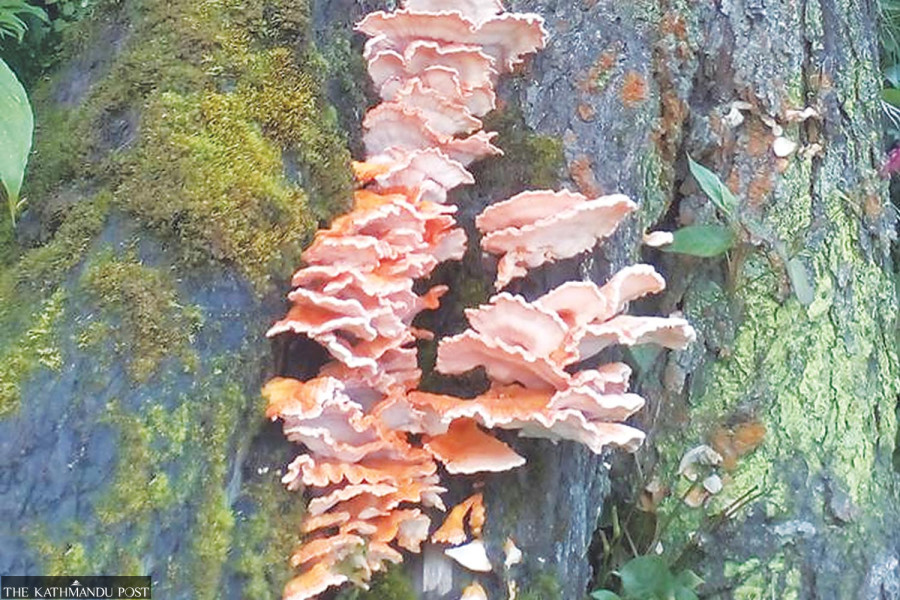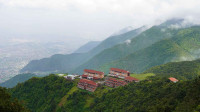Money
Myagdi villagers swarm into forests to pick red mushroom
The locals earn between Rs100,000 and Rs500,000 annually from mushrooms.
Ghanashyam Khadka
Bhumaya Gabruja of Patalekharka is busy this monsoon. Wearing a traditional raincoat, she hops off to Upper Myagdi to pick red mushrooms.
The mushrooms grow in steep and dry places, mainly in the withered brown oak and shorea robusta (Himalayan salla) in the deep forest.
The mushroom collected is consumed in the villages and many hotels in Beni Bazar, the district headquarters, have red mushrooms on their menu.
Traders also supply red mushrooms to Pokhara and other cities.
Kamal Kumari Pun, proprietor of Miteri Local Mart in Beni has been selling local organic products. She said that the demand for red mushrooms is huge. "Almost all department stores, vegetables and street shops sell the red mushroom,” she said.
It costs Rs1,000 per kg for fresh red mushrooms while the price of dried mushrooms is Rs4,000-5,000 per kg. The locals of Gurja, who pick the wild mushrooms and sell them in the market, earn between Rs100,000 and Rs500,000 annually.
People who have consumed red mushrooms say that even meat becomes tasteless after eating the mushroom.
According to the Nepal Agricultural Research Council, red mushrooms contain protein and various minerals.
However, collecting red mushrooms is not easy.
"It's delicious to eat but hard to collect,” said Bhumaya Gabruja.
She said that it is not an easy task to reach the forest. There is a risk of falling prey to tigers and bears.
As the mushroom grows in a dry tall tree, it is risky to climb as well.
Locals have their own skill of picking mushrooms by climbing tall dry trees. First, they hit many strong wooden sticks on a dry tree and climb to pick mushrooms.
Sometimes locals fall from the trees.
Aak Kumar BK, chairman of Lulang, Dhaulagiri Rural Municipali-2, said that with the villagers easily recognising the red mushroom, there is less chance of picking poisonous mushrooms.
The villagers have been heading towards the hills to pick mushrooms by carrying the wooden stick, BK said. “The locals go on foot to the mountains,” he said. Traders reach villages to buy the mushrooms picked by the locals.
Dhanamaya BK of Munaki, Dhaulagiri Rural Municipality-3, said that her family earns more than Rs80,000 annually by picking red and white mushrooms. After finishing the paddy plantation, hordes of locals head to the forest to pick mushrooms, he said.
The red mushroom requires a certain temperature and humidity to grow.
Locals say the best time to pick the mushroom is from the beginning of June to mid-October.
Balbir Chantyal, 76, of Kuine of Raghu Ganga Rural Municipality- 8, said that the mushroom does not grow if there is incessant rainfall.
The red mushroom is collected in Gurja, Lulang, Mudi, Chim River, Kuine, Mangale, Ghasikharka, Ramche and Ghodepani.
As the mushroom is perishable, local people dry it. It is also dried in smoke when there is no sunshine.
According to the District Forest Office, annually 3 tonnes of red mushroom is harvested. Last year, 500 kg of mushrooms were supplied from Myagdi to different cities.
Consumers in urban areas buy them from villages or order them through relatives.
The red mushroom is also exported to Hong Kong, UK, Korea, Japan, US and Belgium.
Nar Bahadur Kshatri, assistant forest officer of the Division Forest Office, said that the demand for red mushrooms has been increasing in urban areas.
The traders are supplying to customers in Kathmandu and exporting to international markets by paying taxes. There is also a growing trend of sending red mushrooms as gifts to relatives abroad, he said.
Jaikant Raut, a senior scientist and member of the National Planning Commission, who has worked as a mushroom expert, said the scientific name of red mushroom is Laetiporus slushies.




 5.14°C Kathmandu
5.14°C Kathmandu















